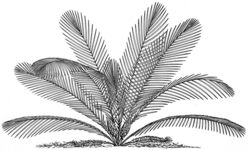Family ZAMIACEAE
Synonyms: Stangeriaceae APNI*

Description: Palm-like plants with stem underground or forming an erect trunk, unbranched or with a few branches, with a crown of spirally arranged pinnate or bipinnate leaves (fronds) and interspersed rudimentary leaves (cataphylls), the leaf bases persistent and covering the stem [or not persistent in some non-N.S.W. species].
Leaves straight and folded in bud; leaf segments, or pinnae, without a midrib, with few to many longitudinal veins, straight in bud.
Plants dioecious; cones rather large, axillary or terminal, with numerous scale-like sporophylls arranged spirally. Male sporophylls (microsporophylls) with many small, globose sporangia clustered in groups in two collateral, sometimes confluent, areas on the undersurface, the sporangia dehiscent by slits. Female sporophylls (megasporophylls) simple, each consisting of a barren stalk and an expanded end, the latter bearing 2 (rarely 3 in Lepidozamia) sessile ovules.
Seeds large, from subglobose to subcylindrical or variously angled; testa with a fleshy outer layer and a woody inner layer; cotyledons 2.
Distribution and occurrence: World: 8 genera, c. 80 species, scattered in tropical to warm-temp. regions of North & South America, Australia & Africa. Australia: 2 genera, 42 species, Qld, N.S.W., N.T., W.A.
External links:
Angiosperm Phylogeny Website (Family: Zamiaceae, Order: Cycadales)
Wikipedia Several native species are cultivated as ornamentals, especially Macrozamia communis L. Johnson and Cycas revoluta Thunb., a native of eastern Asia.
Text by G. J. Harden
Taxon concept:
| | Key to the genera | |
| 1 | Cones of both sexes sessile or subsessile; sporophyll ends tomentose, produced into a spreading, obtuse to acute but not spinose, curved wing; pinnae inserted on the adaxial midline of the rachis; leaf bases shortly tomentose | Lepidozamia |
| Cones pedunculate; sporophyll ends glabrous, often glaucous, terminating in ± erect spine; pinnae inserted near the edges of the rachis; leaf bases densely silky to woolly tomentose with long hairs | Macrozamia |
|


